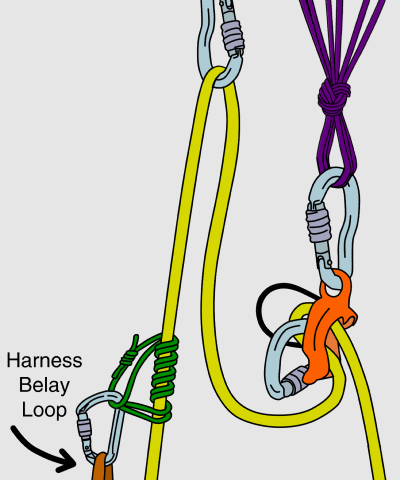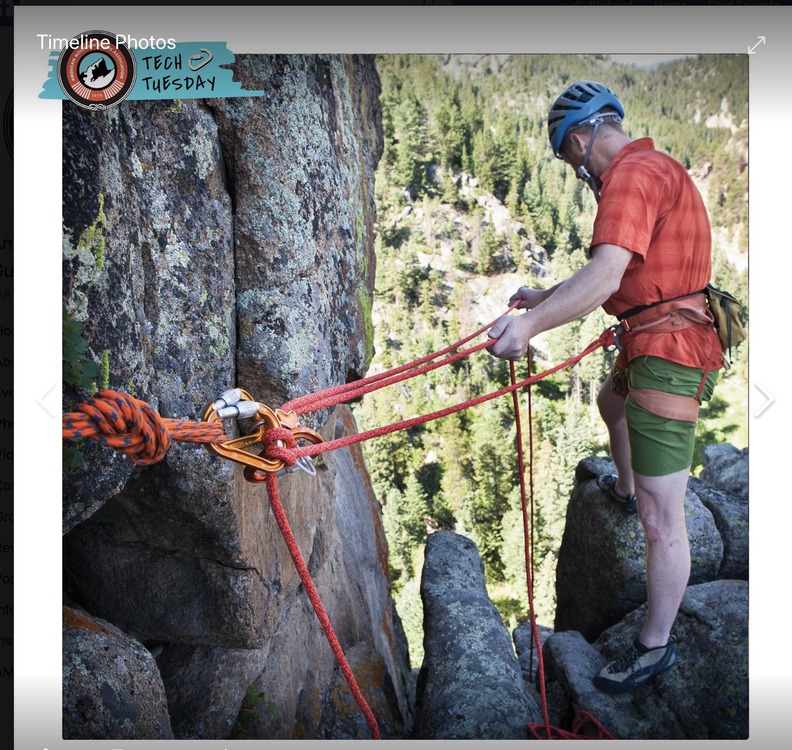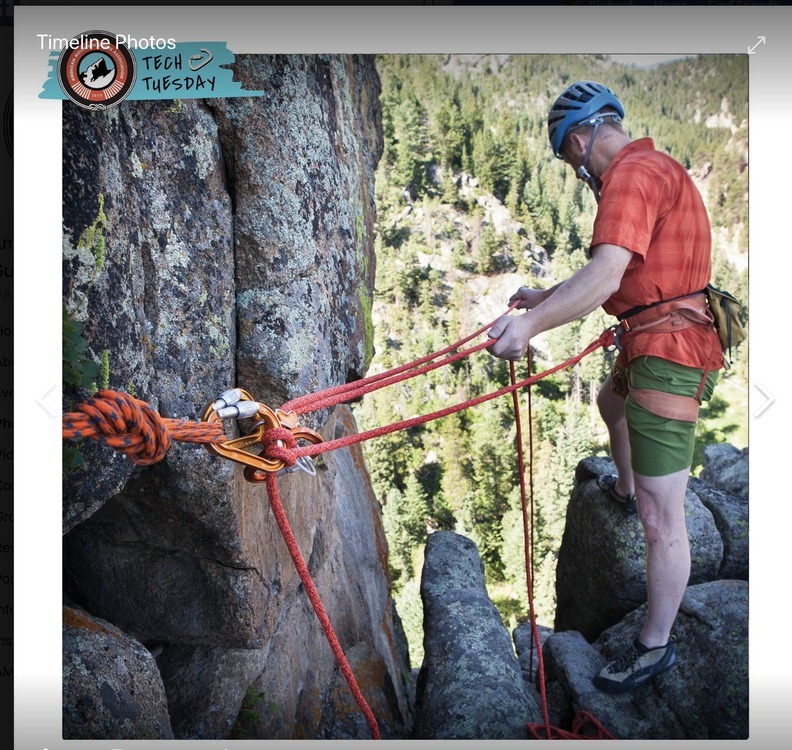Anchor building with the rope
|
|
eli poss wrote: Hi This might be just a question of terminology but what do you mean by a redirect? |
|
|
David, this would be when you place a carabiner higher up in the anchor and clip the rope to that, forming like a mini top-rope. eli poss wrote: Ok, now I get you. The way you said it earlier made it sound like you were releasing the lock unassisted, which was why your lead analogy didn’t make sense to me. |
|
|
So I’ve been messing around with rope anchors a bit and trying to dial a few in. I love how quick Bunny Ears are for 2-bolt anchors, but I’m having trouble getting the length right. Do those of you who use it have a way of consistently grabbing the right length for the bight? Also, I’ve seen some people recommend using the shelf created by the loops for Guide mode, but the knot seems to collapse a bit and act funky when weighted...is this a problem? |
|
|
Ted Pinson wrote: Bunny ears are not redundant, it's a great trick for equalizing things, but it's not something I'd build to toprope off of all day. Depending on the bolts, of course, if it's bomber, its bomber. |
|
|
Ted Pinson wrote: I've owned a DMM Pivot since they first came out. Played around with lowering a bit...better than the other devices, but loss of control still seemed possible to me, just less likely. In any case, as already noted, it doesn't keep the belayer from giving a crappy belay. As for "invalidating all my concerns about guide mode," consider the following shot from the AMGA.What's wrong here? The first thing one notices is the right angle rope bend at the belayer's left hand. If the second falls at this point, that rope is going to straighten out. I'm guessing the horizontal rope segment is about three feet and the vertical segment about 4, so there's seven feet of rope there. But when it straightens out, there will only be the hypotenuse length, which is 5 feet. That leaves 2 feet of slack for the second to fall, not counting additional oi 5--7% rope stretch and the possible displacement of the belayer if he doesn't let go of the load strand. Not a disaster, but far from optimal, and totally an artifact of having selected this belay method. Why doesn't the belayer drop the load strand and just pull in the brake strand? Because the device imposes too much friction that way and it becomes tiring to pull in the rope. Why not stand back by the device? Then the belayer can't see the second. A second reason for the slack-creating right angle might be that the belayer knows he can't reach the device to manipulate it, so can only take in rope. If the belayer wants to let the second actually climb the pitch, including possibly stepping down (or, more critically, stepping back on a traverse), then some slack has to be available, ajd the right angle grip introduces a more or less permanent two feet. Still, this two feet is very awkward to deploy, because the belayer would have to drop the load strand if the second wants to step down, and then either bend over to retrieve it or default to yanking the rope through the plaquette without feeding up the load strand. My take is that over-reliance on the plaquette belay has obscured the fact that a harness belay with the belayer sitting at the lip is a much better solution in this situation. Nobody's gonna die, but there is a much better way to set this up. It is unusual to see such a clear-cut case show up in an AMGA tech tip, but I see climbers who aren't guides making analogous compromises all the time. Plaquette belays have their uses, but trying to force every climbing situation into the plaquette belay mold is going to result and suboptimal belays at least some of the time. |
|
|
adeadhead wrote: Not sure why/how someone would use a rope anchor for toproping nor why you brought back an old thread to say so, but...sure! In what way are they not redundant, and why does it bother you? |
|
|
|
|
|
frog pirate wrote: That's great to know. Never use this knot if you are expecting progressively increasing 10+kN loads for 40+ seconds. Super relevant. |
|
|
And plan on cutting one loop of your climbing rope. |
|
|
Dylan B. wrote: Super redundant. |
|
|
rgold wrote: I think you just made a lengthy post concerning the possibility of 2 feet of slack in a top rope situation. Although not ideal, this situation can exist at any moment during a belay with any device when the follower moves up. I think you are being a bit Gramponian. On a more serious note, what we don't see is how much slack is in the rope below. Because his hand is lifting the rope, he has a good feel of his follower. It is quite possible there is zero slack in the rest of the system. When I use an auto block, I do what I call "playing the bass". By deflecting the load stands a few inches to the side I can put just a bit of tension in the load stand. This gives me intimate sensations of the followers movement. I can react immediately to maintain a very close beley for my follower. It also give me a few inches of slack to easily give when needed without touching the belay device. A good belay has much more to do with the belayer and his or her attention to the task at hand as opposed to the device in use. |
|
|
This picture makes me barf. Seriously, these AMGA staged photos are intended to promote Petzl and the AMGA to noobs. As Rich points out, this belayer is in poor position to do his job but he looks all "guide-like" and has lots of shiny biners (BUY PETZL!! YOU NEED MORE LOCKERS!!). And if I ever use 3 lockers to set up an anchor to belay someone up a 5.6 you can give me a really mean pinch and tell me to knock it off. Pathetic. |
|
|
Harumpfster Boondoggle wrote: You mean 5 lockers. I bet they're on the hangers too... |
|
|
William P wrote: Exactly. It is selling climbing as "gear based" rather than based on skill and knowledge. Must. Have. Petzl. And. Guide. To. Climb. |
|
|
Kyle Tarry wrote: And there you have it. You completely cannot grasp the point. Here, this is from Black Diamond just for you (related, but you won't get it): "Do not rely on only one anchor or connect to your anchors with only one piece of gear such as one Daisy Chain or one carabiner. Use multiple anchors and redundant connection equipment whenever possible." But that AMGA guide sure is pro! (at selling Petzl lockers to noobs). You simply cannot grasp that selling gear and the AMGA is the entire purpose of the image. Not a demonstration of ideal practice. That's how the industry works. |
|
|
One locker is all you need. Figure it out. |
|
|
Greg D wrote:I don't know what "Gramponian" means, but wouldn't be surprised to find I'm guilty of it. If it is age-related, I'm certainly old enough to be a grampa, although my daughter refuses to cooperate with the realization of that status. Two feet of slack in an upper belay is not a catastrophe, but it has negative potential. The main point I think your comment obscures is that all the other ways of accumulating two feet of slack are still in operation, so that the two feet of slack we can see is going to be added to whatever else occurs during the belay. True enough, but by your own testimony it is also quite possible that there could be another two feet there. And four feet of slack plus the inherent rope stretch is starting to look like a bad deal.
I do the same thing when I use a plaquette. But my Gramponian point was that this is a flawed stance---and not only because of the embedded slack---with a much better one easily rigged, indicating how plaquette-centric thinking can obscure the best way to deal with such situations. |
|
|
Harumpfster Boondoggle wrote: No thanks, I prefer not to have to climb with a wrench or have to cut myself out of a belaying due to my lockers binding (done both due to petzl lockers). Thanks anyways Petzl.... (Seriously... Their screwlocks need to be redesigned...) |
|
|
[This written in response to a subsequently deleted post.] |
|
|
rgold wrote: I do the same thing when I use a plaquette. But my Gramponian point was that this is a flawed stance---and not only because of the embedded slack---with a much better one easily rigged, indicating how plaquette-centric thinking can obscure the best way to deal with such situations. There were some other posters that I think saw the "truth" of this photo: that it is an advertisement and not a training tool. they just wanted maximum exposure to the brand. I agree that this is a belay that screams for a waist belay and redirect (or even a hip belay, lots of places to brace your feet ) . And since when did it become paramount to see the second climb? I would say most routes don't afford a view of the line at the next belay, and you should develop a "feel" for belaying a second when they're out of sight. Unless you are belaying two people, I prefer a GriGri over the guide mode ATC by a wide margin. Simply for the ease of lowering. |

 Continue with onX Maps
Continue with onX Maps Continue with Facebook
Continue with Facebook
























